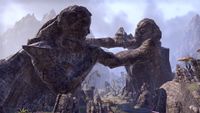Lore:Brothers of Strife (place)
| Brothers of Strife | |
|---|---|
| Type | Ruins |
| Continent | Tamriel |
| Province | Morrowind |
| Region | Stonefalls |
| Appears in | ESO |

The Brothers of Strife is the name of the enormous stone statue towering over ancient Chimer ruins located far south of Ebonheart, in the Stonefalls region of Morrowind. It was named after the Brothers of Strife, two monsters created there. The area is rich in heart stone deposits.
The ruins were originally built as a Daedric shrine by the Daedra-worshipping Chimer. In the early First Era,[1] the ruins were the location of the Chimer army's last stand after Nedes from Skyrim conquered all of Stonefalls. Despite the dangers, the Chimer performed a dark ritual to summon the Brothers of Strife as a last resort, using flame atronach essences and the hearts of their Nedic enemies, and offering two of their leaders as sacrifices. The monsters succeeded in crushing the Nedes and liberating Stonefalls, but continued to rampage, forcing the Chimer to bind them atop Ash Mountain and the Tormented Spire. The spirits of General Balreth and Legate Sadal, the two Chimer who were sacrificed, lingered at the ruins. Statues were later built to commemorate their sacrifice.[2]
In 2E 582, a researcher from Great House Telvanni named Sorcerer Vunal came to the Brothers of Strife to learn what had happened during the battle. However, Daedric magic still permeated the area, and he was driven off by the many scamps that are constantly summoned to the ruins. The Vestige later arrived at the ruins, and helped Vunal collect heart stones to establish a link to the past. Through contacting the spirits of the Chimer generals and ritualistically offering the heart stones at a Daedric altar, the Vestige was shown a vision of the past, allowing Vunal to complete his research.[3]
Notes[edit]
- M'aiq the Liar claims that Ash Mountain and the Tormented Spire are also named the Brothers of Strife, but there's no other evidence to support this.[4]
See Also[edit]
- For game-specific information, see the Elder Scrolls Online article.
References[edit]
- ^ Sorcerer Vunal's dialogue in ESO
- ^ The Brothers of Strife — Nili Omavel
- ^ Events of ESO
- ^ M'aiq's dialogue in ESO